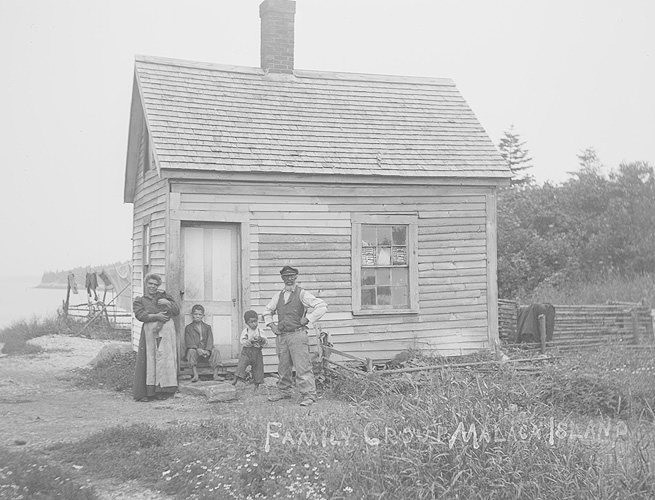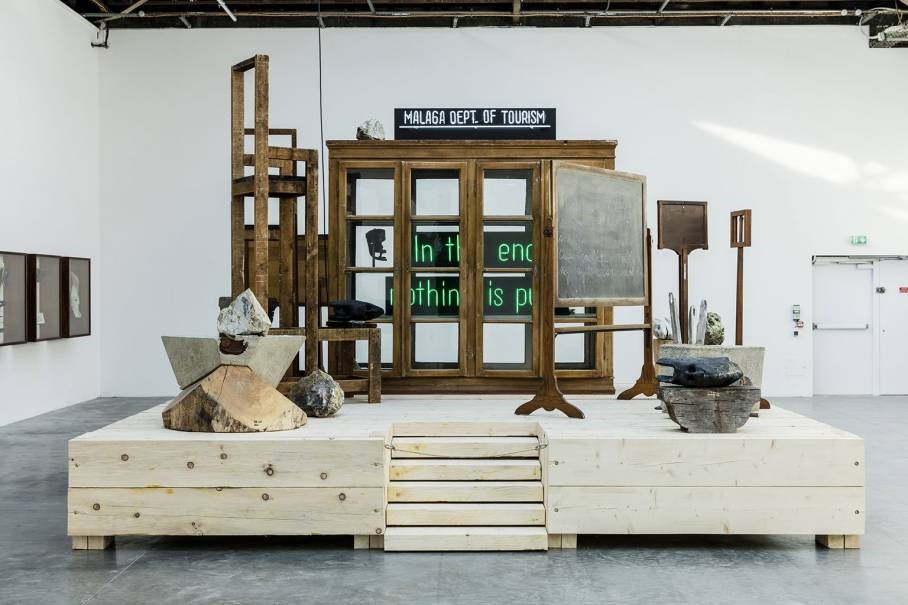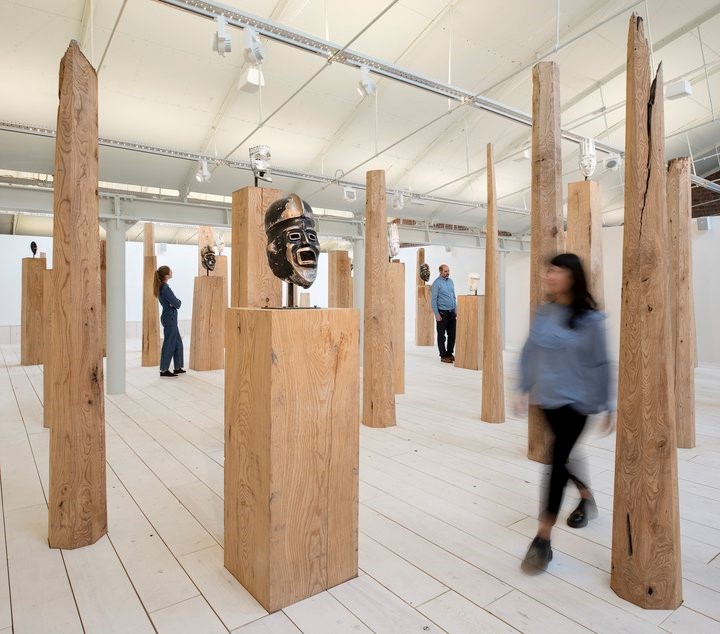STAAR Spark Reviews
Siân Round
MSt. in English and American Studies
——————————–
Online since: 15 March 2020
Review process: Editorial Review
Theaster Gates, AMALGAM (2020) Exhibition
Curated by: Tate Liverpool
https://www.tate.org.uk/whats-on/tate-liverpool/exhibition/theaster-gates-amalgam
On the fourth floor of a building on the Royal Albert Dock, visitors to the Tate Liverpool are invited to look out of the window at the now famous view across the River Mersey. Looking inland, they can see Liverpool’s famous Three Graces: The Royal Liver Building, The Cunard Building and the Port of Liverpool Building. The environs of the Tate Liverpool tell a story of the city’s wealth as a port, the second city of the British Empire. Across from the gallery, however, there is a different story to be told. The International Slavery Museum, opened on the Albert Dock in 2007, focuses on the history and legacy of the transatlantic slave trade in Liverpool. Between 1695 and 1807, over five thousand voyages to Africa were made from Liverpool with the purpose of transporting African people to the Americas. As the ‘Liverpool and Slavery’ Twitter project states, ‘Beyond a doubt it was the slave trade that raised Liverpool from a struggling seaport to be one of the richest and most prosperous trading centres of the world.’ The story of the Albert Dock is that of a city whose wealth came from the trading of black lives, a story which is told in the names of the streets.

A Farmhouse on Malaga, Copyright: Maine State Museum
Inside the Tate Liverpool, a further story is being told. In 1912, the residents of the small island of Malaga, off the coast of Maine, were all evicted with no offer of support. The school was closed, and all the buildings were left derelict. Many of the citizens were placed in mental institutions. There was no illness on Malaga Island. Rather, it was a utopian integrated community, in a segregated United States. Governor Frederick W. Plaisted felt the island was damaging his state’s reputation and forcibly removed all the island’s residents, even digging up graves and moving the bodies to the mainland (Maine State Museum 2018). The shocking, and forgotten, history of Malaga Island provides the inspiration for Chicago artist Theaster Gate’s exhibition AMALGAM which is showing at Tate Liverpool until 3rd May. In this review, I examine how the physicality of Gates’ exhibition interacts with the city in which it is being shown, and how AMALGAM makes its viewer consider how space is occupied and passed down.
Signs and Materials
Theaster Gates, born in 1973, is a social practice installation artist based in Chicago. He works across many media and is particularly interested in the redevelopment and occupation of space, as shown by his founding of the Rebuild Foundation, which revitalises communities and buildings in neglected areas of Chicago. AMALGAM, Gates’ first UK solo exhibition, makes use of the same mixture of media for which he has become known: each installation in the exhibition is made of a different material and takes on a different form. This is reflected in the multiple meanings of the exhibition’s title. AMALGAM is a near anagram of Malaga, but it also provides a second meaning of the mixed, interracial community, and perhaps a third meaning referring to the exhibition’s mix of materials and forms. When first entering the exhibition, you are faced with a large black slope made of slate, resembling a rooftop, as if the rest of the house is buried. Behind that is a rotating neon sign with the word MALAGA written on it. The sign is literally advertising the place, forcing it to be recognised, while the slope highlights what isn’t there, the missing pieces of Malaga. The sign is placed on top of more pieces of slate. The reference is to plans to build a resort on Malaga, as referenced later in another neon sign for ‘Malaga Dept. of Tourism’. The opening room of the exhibition introduces you to what Gates cites as one of his most important themes: monumentality (Perchuk 2019). That is, both the physicality and scale of the exhibition’s pieces and the significance of their history. Gates’ interpretation of Malaga Island constantly draws attention to what stories we tell.
The monumentality of the exhibition forces the history of Malaga upon the viewer, often in a way which seems heavy-handed. It is easy to go through this exhibition with a cynical view. The great injustice of the island’s evacuation, and of racial segregation itself, surely hardly needs to be told in 2020. However, it is through Gates’ uses of different media and materials that he builds a more pertinent message of what is allowed to be passed on, and, indeed, what is regarded as valuable.

Copyright: Theaster Gates, Photo: Chris Strong
‘Black Space’
A later part of the exhibition features Gates’ approximation of an island, with scattered rocks as well as a blackboard, a chair, and a large cabinet, employing his frequent method of placing natural and manufactured materials side-by-side. The impression is of the schoolroom at Malaga, in which both black and white children were taught as equals. On this invented island, another neon sign tells the viewer that ‘In the end nothing is pure.’ This can be read as a complaint that the purity of the interracial classroom has been destroyed but, particularly within the context of the gallery, the sign tells us something else. The very exhibition in which this story is being told is in a building built from the profits of slavery. Many of its visitors have profited indirectly from slavery. Everything which is passed down is part of a complex history so that even the idealism of Malaga Island and the injustice of its destruction cannot be told as a story without being interwoven with the traumas of the past. If the theme of the exhibition is a question of what is passed on, and who profits from history, the exhibition’s answer is that white people still profit. These ideas are an important part of Gates’ other work. The Dorchester Art and Housing Collaborative is a project initiated by Gates which provides thirty-two units for creative space for those with low income in Chicago. His work demands space while asking who occupies and controls it. Gates’ website states that ‘In all aspects of his work, he contends with the notion of Black space as a formal exercise.’ (Gates 2019).
With this in mind, this exhibition is one which investigates how the creation of ‘Black space’ interacts with history. Another installation in AMALGAM is a large blackboard on which Gates has written a history of slavery. The piece is a sprawling mind-map, linking together events from the seventeenth to twentieth centuries. In the top right corner, Gates proudly tells us ‘1973: Theaster Gates is born a free man.’ Other writings state that ‘WE ARE ALL MIXED.’ This installation, more than any other in the exhibition, hints that this is an American story. It is only as we go throughout the exhibition, with an eye out of the window at the world around the gallery, that we realise that the history of slavery is not simply an American story. The history of the transatlantic slave trade is a story of movement and impermanence, just like the story of Malaga. The exhibition, then, attempts to reclaim space for African Americans, while revealing that such space is held by those with power.
Monumentality and Impermanence

Copyright: Tate Liverpool, Photo: Roger Sinek
The final room of the exhibition houses the largest installation and the most successful attempt by Gates to create a piece so monumental that it demands space. Titled ‘So Bitter This Curse of Darkness’, it features a series of masks on pillars made from dying ash trees. Gates states in the exhibition: ‘These trees were dying. A miller said they were not fit for timber. Useless. Somewhere in the death of a tree is the truth of its strength.’ (Tate 2020). Gates has taken something that has lost its intended value and has fit it to his purpose; he is literally reclaiming space. This final room is large and echoing, and the wood creates an uneven floor. The visitor is taken out of the exhibition space and placed into a kind of manufactured forest. Gates’ exhibition always teeters between the natural and the manufactured, eliding the differences between the two, highlighting the significance of mixedness to his work. The final room takes the viewer outside the gallery space, into a separate space in which you are permitted to touch the wooden pillars. In this sense, the viewer is taken to Malaga; they are occupying its space by bearing witness to it. The repurposed pieces of wood, replicating the trees they used to be, hints at the impermanence of the space we occupy, and the reality of environmental catastrophe.
As you walk through the exhibition, the juxtaposition between this destroyed island community and the city outside provokes many questions. Who determines what is valuable and what is worth keeping? Gates’ exhibition tells a story of what is passed on, and what history is maintained in the process. While the exhibition had previously been shown at the Palais de Tokyo in Paris, it takes on a new significance in Liverpool. Ten years ago, Tate Liverpool hosted Afro Modern: Journeys Through the Black Atlantic, an exhibition inspired by Paul Gilroy’s seminal book, The Black Atlantic. (Gilroy 1993). The exhibition highlighted the hybridity of modernity which emerged from transatlantic black culture. As a city which was at the heart of the transatlantic slave trade, this city-wide celebration of black culture was an important step to reclaiming the importance of black people in Liverpool. Theaster Gates’ exhibition, in contrast, is far from a celebration. It is a cry to force people to recognise the spaces that black people occupy, and the spaces which have been taken away from them.
Inheritance and Afterlives
The synthesis of Gates’ themes of how space is occupied, owned, and passed down, and their importance beyond America, is made clearest in the 30-minute video, Dance of Malaga, the exhibition’s centrepiece. Once again combining different forms, the video features choreographed performance of dancers on the island in a collaboration with Kyle Abraham, interspersed with clips from documentaries, and a shocking scene from Douglas Sirk’s Imitation of Life (1959) in which a woman is beaten for having African American heritage. The film is scored by Gates’ band The Black Monks who take inspiration from the blues and gospel traditions of African American communities in the southern United States. Perhaps one of the most pertinent clips comes from an advert for Patek Philippe watches, in which a young child comes downstairs interrupting her mother’s dinner party. The advert then tells us that you don’t really buy a watch for yourself, but to pass down to the next generation. Within this video installation, Gates tells the viewer that the history of Malaga is not just a history of segregation. The residents of Malaga were not able to pass their wealth down to the next generation; the story of Malaga is as much a story about property and ownership as it is about segregation.

Still from ‘Dance of Malaga’. Copyright: Theaster Gates, Photo: Chris Strong
AMALGAM is not an exhibition about the slave trade, but about its afterlives, and it is exactly this which makes its appearance so important in Liverpool today. Gates’ use of multiple forms intersects with his questions of ownership and value. By working across media, Gates not only suggests that the worth of art is not restricted to a form but also, by participating across forms, he is reclaiming a space for black voices, a space which operates across the natural and the manufactured. AMALGAM holds onto a history that is asking to be forgotten, just as Liverpool is built on a history its residents often ignore. Gates creates a monument to Malaga while questioning the history of monumentality and how space is occupied.
Bibliography:
Afro Modern: Journeys Through The Black Atlantic (2010) [Exhibition]. Tate Liverpool, Liverpool. 29 January – 25 April 2010.
Gilroy, P., The Black Atlantic: Modernity and Double Consciousness (London: Verso, 1993).
Liverpool and Slavery, Twitter. Available at: https://twitter.com/AndSlavery?s=20. (Accessed 04/03/2020).
Maine State Museum (2018), ‘Malaga Island: The History’. Available at: https://mainestatemuseum.org/learn/malaga-island-fragmented-lives-educational-materials/the-history/.
Perchuk, A. and Theaster Gates (2019) ‘Dance of Malaga: A Conversation with Theaster Gates’, The Getty Centre. Available at: https://www.youtube.com/watch?v=Cammz0BMWKU.
Tate (2020), ‘Five Things to Know About Theaster Gates’. Available at: https://www.tate.org.uk/art/artists/theaster-gates-17216/five-things-know-about-theaster-gates.
Theaster Gates (2019), ‘About’. Available at: https://www.theastergates.com/about.
Theaster Gates: AMALGAM (2019) [Exhibition]. Tate Liverpool, Liverpool. 13 December 2019 – 3 May 2020.
 AMALGAM:Theaster Gates, Liverpool, and Monumentality by Siân Round is licensed under a Creative Commons Attribution 4.0 International License.
AMALGAM:Theaster Gates, Liverpool, and Monumentality by Siân Round is licensed under a Creative Commons Attribution 4.0 International License.
<< Back to Spark Reviews
<< Back to Publications
St Anne's Academic Review (STAAR) A Publication by St Anne's College Middle Common Room ISSN 2048-2566 (Online) ISSN 2515-6527 (Print)
